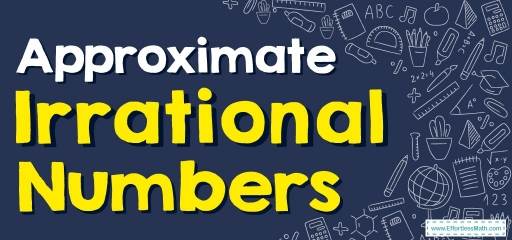How to Approximate Irrational Numbers? (+FREE Worksheet!)

This article teaches you how to Approximate Irrational Numbers in a few simple steps.
Related Topics
- How to Simplify Radical Expressions
- How to Solve Radicals
- How to Solve Radical Equations
- How to Rationalize Radical Expressions
Step by step guide to Approximate Irrational Numbers
Numbers that cannot be written as a fraction are called irrational. An irrational number is a non-repeating, non-terminating decimal and it does not have an exact place on the number line. Square roots of numbers that are not perfect squares are irrational.
We use approximations of irrational numbers to locate them approximately on a number line diagram.
Since the irrational numbers are radical numbers that are not a perfect square, to approximate them, follow the steps below
- Step 1: First, we need to find the two consecutive perfect squares that the number is between. if
is our number, we can do this by writing this inequality: \(a^2< x <b^2\)
- Step 2: Take the square root of each number:\(\sqrt{a^2}< \sqrt{x} <\sqrt{b^2}\)
- Step 3: Simplify the square roots of perfect squares:\(a< \sqrt{x} <b\), then, \(\sqrt{x}\) is between \(a\) and \(b\).
- Step 4: To find a better estimate, choose some numbers between \(a\) and \(b\).
Approximating Irrational Numbers – Example 1:
Find the approximation of \(\sqrt{22}\)
Solution:
since \(\sqrt{22}\) is not a perfect square, is irrational. To approximate \(\sqrt{22}\) first, we need to find the two consecutive perfect squares that \(22\) is between. We can do this by writing this inequality: \(16< 22 <25\). Now take the square root of each number: \(\sqrt{16}< \sqrt{22} <\sqrt{25}\). Simplify the square roots of perfect squares:
\(4< \sqrt{22} <5\), then, \(\sqrt{22}\) is between \(4\) and \(5\). To find a better estimate, choose some numbers between \(4\) and \(5\) Let’s choose \(4.6\), \(4.7\) and \(4.8\).
\(4.6^2=21.16\), \(4.7^2=22.09\), \(4.8^2=23.04\), \(4.7\) is closer to \(22\). Then: \(\sqrt{22}≈4.7\)
Approximating Irrational Numbers – Example 2:
Find the approximation of \(\sqrt{74}\)
Solution:
since \(\sqrt{74}\) is not a perfect square, is irrational. To approximate \(\sqrt{74}\) first, we need to find the two consecutive perfect squares that \(74\) is between. We can do this by writing this inequality: \(64< 74 <81\). Now take the square root of each number: \(\sqrt{64}< \sqrt{74} <\sqrt{81}\). Simplify the square roots of perfect squares:
\(8< \sqrt{74} <9\), then, \(\sqrt{74}\) is between \(8\) and \(9\). To find a better estimate, choose some numbers between \(8\) and \(9\) Let’s choose \(8.5\), \(8.6\) and \(8.7\).
\(8.5^2=72.25\), \(8.6^2=73.96\), \(8.7^2=75.69\), \(8.6\) is closer to \(74\). Then: \(\sqrt{74}≈8.6\)
Approximating Irrational Numbers – Example 3:
Find the approximation of \(\sqrt{94}\)
Solution:
since \(\sqrt{94}\) is not a perfect square, is irrational. To approximate \(\sqrt{94}\) first, we need to find the two consecutive perfect squares that \(94\) is between. We can do this by writing this inequality: \(81< 94 <100\). Now take the square root of each number: \(\sqrt{81}< \sqrt{94} <\sqrt{100}\). Simplify the square roots of perfect squares:
\(9< \sqrt{94} <10\), then, \(\sqrt{94}\) is between \(9\) and \(10\). To find a better estimate, choose some numbers between \(9\) and \(10\) Let’s choose \(9.6\), \(9.7\) and \(9.8\).
\(9.6^2=92.16\), \(9.7^2=94.09\), \(9.8^2=96.04\), \(9.7\) is closer to \(94\). Then: \(\sqrt{94}≈9.7\)
Approximating Irrational Numbers – Example 4:
Find the approximation of \(\sqrt{26}\)
Solution:
since \(\sqrt{26}\) is not a perfect square, is irrational. To approximate \(\sqrt{26}\) first, we need to find the two consecutive perfect squares that \(26\) is between. We can do this by writing this inequality: \(25< 26 <36\). Now take the square root of each number: \(\sqrt{25}< \sqrt{26} <\sqrt{36}\). Simplify the square roots of perfect squares:
\(5< \sqrt{26} <6\), then, \(\sqrt{26}\) is between \(5\) and \(6\). To find a better estimate, choose some numbers between \(5\) and \(6\) Let’s choose \(5.1\), \(5.2\) and \(5.3\).
\(5.1^2=26.01\), \(5.2^2=27.04\), \(5.3^2=28.09\), \(5.1\) is closer to \(26\). Then: \(\sqrt{26}≈5.1\)
Exercises for Approximating Irrational Numbers
Find the approximation of each.
- \(\color{blue}{\sqrt{41}}\)
- \(\color{blue}{\sqrt{52}}\)
- \(\color{blue}{\sqrt{59}}\)
- \(\color{blue}{\sqrt{72}}\)
- \(\color{blue}{\sqrt{17}}\)
- \(\color{blue}{\sqrt{10}}\)

- \(\color{blue}{6.4}\)
- \(\color{blue}{7.2}\)
- \(\color{blue}{7.7}\)
- \(\color{blue}{8.5}\)
- \(\color{blue}{4.1}\)
- \(\color{blue}{3.2}\)
Related to This Article
More math articles
- Top 10 3rd Grade PSSA Math Practice Questions
- 4th Grade ISASP Math Worksheets: FREE & Printable
- FREE 3rd Grade STAAR Math Practice Test
- CHSPE Math Formulas
- 6th Grade MAP Math Practice Test Questions
- Top 10 7th Grade MEAP Math Practice Questions
- CLEP College Algebra Worksheets: FREE & Printable
- Categorization of Differential Equations: An Expert Classification
- The Ultimate 7th Grade SC Ready Math Course (+FREE Worksheets)
- 10 Most Common 4th Grade OST Math Questions




















What people say about "How to Approximate Irrational Numbers? (+FREE Worksheet!) - Effortless Math: We Help Students Learn to LOVE Mathematics"?
No one replied yet.